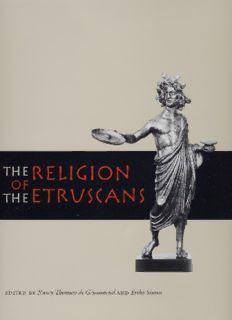
The Religion of the Etruscans PDF
Preview The Religion of the Etruscans
THE RELIGION OF THE ETRUSCANS THIS PAGE INTENTIONALLY LEFT BLANK THE RELIGION OF THE ETRUSCANS Nancy Thomson de Grummond and Erika Simon, Editors Universityof TexasPress Austin SelectionsfromvolumesintheLoebClassicalLibrary® arereprintedinAppendixB(p.191).TheLoebClassical Library®isaregisteredtrademarkofthePresidentand FellowsofHarvardCollege. Copyright©2006bytheUniversityofTexasPress Allrightsreserved PrintedintheUnitedStatesofAmerica Firstedition,2006 Requestsforpermissiontoreproducematerialfromthiswork shouldbesentto: Permissions UniversityofTexasPress P.O.Box7819 Austin,TX78713-7819 www.utexas.edu/utpress/about/bpermission.html (cid:10)Thepaperusedinthisbookmeetstheminimum requirementsofansi/nisoz39.48-1992(r1997) (PermanenceofPaper). LibraryofCongressCataloging-in-PublicationData ThereligionoftheEtruscans/NancyThomson deGrummondandErikaSimon,editors.—1sted. p. cm. Includesbibliographicalreferencesandindex. isbn0-292-70687-1(cloth:alk.paper) 1.Etruscans—Religion—Congresses. I.DeGrummond, NancyThomson. II.Simon,Erika. bl740.r45 2006 299'.9294—dc22 2005022652 CONTENTS Editors’Note vii ListofAbbreviations viii ContributorstoThisVolume ix Preface xi W.JeffreyTatum I. Introduction:TheHistoryoftheStudyofEtruscanReligion 1 NancyThomsondeGrummond II. EtruscanInscriptionsandEtruscanReligion 9 LarissaBonfante III. ProphetsandPriests 27 NancyThomsondeGrummond IV. GodsinHarmony:TheEtruscanPantheon 45 ErikaSimon V. TheGraveandBeyondinEtruscanReligion 66 IngridKrauskopf VI. VotiveOfferingsinEtruscanReligion 90 JeanMacIntoshTurfa VII. RitualSpaceandBoundariesinEtruscanReligion 116 IngridE.M.Edlund-Berry VIII. SacredArchitectureandtheReligionoftheEtruscans 132 GiovanniColonna Glossary 169 AppendixA:TheEtruscanBrontoscopicCalendar 173 JeanMacIntoshTurfa AppendixB:SelectedLatinandGreekLiterarySourcesonEtruscanReligion 191 NancyThomsondeGrummond Index 219 THIS PAGE INTENTIONALLY LEFT BLANK EDITORS’ NOTE In The Religion of the Etruscans the abbreviations of jour- attempted to use ancient names; these are mainly Roman. nals and series as well as of basic reference works in clas- ThuswerefertoCaere,Populonia,Veii,Vetulonia,andVulci, sical studies are those used by the American Journal of in accordance with established custom, and also the less Archaeologyandlistedinaja104(2000),10–24.Anupdated commonformsofTarquiniiandVolaterrae.ThenamesCer- versionisonthewebsite:http://www.ajaonline.org/shared/ veteri,Tarquinia,andVolterraareusedtorefertothemod- s info contrib 7.html. erncitieswiththosenames.SomescholarsrefertoOrvieto A glossary of technical terms and words that may be astheancientVolsiniiandtoBolognaasFelsina.Whenno otherwiseunfamiliartothereaderisprovidedatthebackof ancient name is known or agreed upon, we use the mod- thisbook.Wordsthatareincludedintheglossaryareregu- ernItalianname.Forthenamesoftombs,wehaveoptedfor larly marked with an asterisk in the text the first time the translatingthemanyItaliannamesintoEnglishasapolicy termisusedinaparticularchapter(e.g.,templum*).Thereis thatwillhelpmakethevocabularyof Etruscanscholarship alsoaglossaryofthemostimportantEtruscangodsbyErika morereadilyaccessibletostudentsandtootherswhomay SimoninChapterIV. bebeginningthestudyoftheEtruscans. The spellings used for the names of the gods in Chap- The appendices provide a Greek text and an English ter IV are used as much as possible throughout the book. translationoftheEtruscanBrontoscopicCalendar,aswellas Etruscan orthography, however, was by no means consis- keyoriginaltextsinLatinandGreek,withEnglishtransla- tent, and references may be made to inscriptions in which tions. anamehasanalternatespelling.Adifferentkindofprob- ThestandardchronologyoftheperiodsofEtruscancul- lem arises for nomenclature because we do not know the tureisasfollows: namesinEtruscanofmanyofthearchaeologicalsitesmen- IronAge/Villanovan—1000/900–750/700bce tioned in this book. Many scholars use a blend of modern Orientalizing—750/700–600bce Italian,ancientRoman(i.e.,Latin),andoccasionally,Etrus- Archaic—600–475/450bce can,namesforEtruscancitiesandothersites,andthisbook ‘‘Classical’’—475/450–300bce isnoexception. Hellenistic—300bce–firstcenturybce MapsshowingthemajorEtruscancitiesandmountains FordatesofLatinandGreekauthorsandofselectedtexts, may be found on page 124. As much as possible we have seetheappropriateentriesintheindex. vii LIST OF ABBREVIATIONS Thefollowingworksaresofrequentlyusedthroughoutthe bookthatitseemedappropriatetogiveabbreviationstothem: anrw=AufstiegundNiedergangderrömischenWelt, ed.H.Temporini.Berlin,1972–. cie=CorpusInscriptionumEtruscarum. cse=CorpusSpeculorumEtruscorum. Dizionario=DizionariodellaCiviltàEtrusca, ed.M.Cristofani.Florence,1985. ehca=AnEncyclopediaoftheHistoryofClassical Archaeology,ed.N.T.deGrummond.2vols. Westport,1996. es=EtruskischeSpiegel,ed.E.Gerhard,G.Körte,and A.Klügmann.5vols.Berlin,1840–1897. et=H.Rix,EtruskischeTexte.2vols.Tübingen,1991. EtruscanPainting=S.Steingräber,EtruscanPainting: CatalogueRaisonnéofEtruscanWallPaintings, ed.D.RidgwayandF.R.Ridgway.NewYork,1986. limc=LexiconIconographicumMythologiaeClassicae lprh=LesÉtrusques,lesplusreligieuxdeshommes:État delarecherchesurlareligionétrusque.Actesducolloque internationalGrandPalais17–19.11.1992,ed.D.Briquel andF.Gaultier.Paris,1997. Rasenna=Rasenna:Storiaeciviltàdeglietruschi, ed.M.Pallottinoetal.Milan,1986. ThLE=ThesaurusLinguaeEtruscae,ed.M.Pandolfini Angeletti.Rome,1978–. tle=TestimoniaLinguaeEtruscae,ed.M.Pallottino. 2nded.Florence,1968. viii CONTRIBUTORS TO THIS VOLUME Larissa Bonfante is Professor of Classics at New York Morgantina in Sicily and in collaboration with Lucy Shoe University. She is the author of Etruscan Dress (new ed., MeritthasrecentlypublishedareissueofEtruscanandRe- 2003)andTheEtruscanLanguage(2nded.,2002,withGiu- publicanRomanMouldings(2003). lianoBonfante)andisauthorandeditorofEtruscanLifeand Ingrid Krauskopf is Professorat the Universityof Hei- Afterlife:AHandbookof EtruscanStudies(1986).Since1974 delbergandassociateoftheHeidelbergAcademyofScience, shehasservedasthechairoftheU.S.CommitteefortheCor- where she has guided thework of the Lexicon Iconographi- pus of Etruscan Mirrors (Corpus Speculorum Etruscorum). cum Mythologiae Classicae (limc). She has published nu- SheistheauthorofnumerousarticlesonEtruscanciviliza- merousarticlesandbooksonEtruscanmythologyandreli- tion,dress,language,andart. gion, including the basic book on Etruscan demonology, GiovanniColonnaisProfessorofEtruscologyandItalic Todesdämonen und Totengötter in der vorhellenistischen Kunst(1987),andnumerousarticlesonEtruscanmythology Archaeology at the University of Rome ‘‘La Sapienza.’’ He inthelimc. has directed the excavations at the Etruscan sanctuary of Pyrgisinceitsinceptioninthe1950sandhaspublishednu- Erika Simon, who served as Langford Family Eminent merous reports on his results. He is the author of Bronzi ScholarinClassicsatFloridaStateUniversityin1999,isPro- umbro-sabellici(1970)and,withElenadiPaolo,Casteld’Asso fessorEmeritaof WürzburgUniversity,wheresheheldthe (1970)andNorchia(1978).Manyofhismorethanthreehun- chairforClassicalArchaeologyandservedasdirectorofthe dredarticlesonvarioustopicsarenowcollectedinItaliaante antiquitiessectionoftheMartin-von-WagnerMuseum.She RomanumImperium,I–IV,Pisa/Rome,2005.Hehascurated istheauthororeditorofmanybooksonGreek,Roman,and anumberofmuseumexhibitions,themostnotableofwhich Etruscanart,myth,andreligion,includingAraPacisAugus- washisSantuarid’Etruria(1985). tae(1968),Augustus:KunstundLebeninRomumdieZeiten- wende(1986),SchriftenzuretruskischenunditalischenKunst Nancy Thomson de Grummond is the M. Lynette undReligion(1996). Thompson Professorof Classics at Florida State University (fsu). She specializes in Etruscan, Roman, and Hellenis- W.JeffreyTatumistheOliviaDormanProfessorofClas- ticartandarchaeology,withaparticularconcentrationon sicsatFloridaStateUniversity.Aspecialistintheliterature Etruscanmythandreligion.Sheservesasdirectorofexcava- andhistoryoftheLateRomanRepublic,heistheauthorof tionsatCetamuradelChiantiundertheauspicesofthefsu numerousarticlesandofthevolumeThePatricianTribune: ArchaeologyProgramsinItaly.HerpublicationsincludeA PubliusClodiusPulcher (ChapelHill,NC,1999).Heiscur- GuidetoEtruscanMirrors(Tallahassee,FL,1982)andEtrus- rentlywritingacommentaryontheCommentariolumPeti- can Mythology, Sacred Historyand Legend: An Introduction tionisforOxfordUniversityPress. (forthcoming, Publications of the University of Pennsylva- niaMuseum). Jean MacIntosh Turfa is a Research Associate at the University of Pennsylvania Museum. Recent publications Ingrid E. M. Edlund-Berry isProfessorofClassicsand have been in the fields of Etruscan architecture, Etruscan Classical Archaeologyat the Universityof Texas at Austin. votive offerings, art and myth in the Greek colonies, and SheistheauthorofTheIronAgeandEtruscanVasesinthe parasolsinEtruscanart.Sheservedasconsultantforthein- Olcott Collection at Columbia University, New York (1980), stallation of the new galleries of Etruscan and Faliscan an- The Gods and the Place (1987), and The Seated and Stand- tiquitiesintheUniversityMuseum,nowpublishedasCata- ingStatueAkroteriafromPoggioCivitate(Murlo)(1992).She logueoftheEtruscanGalleryoftheUniversityofPennsylvania has completed a publication of the Central Sanctuary of MuseumofArchaeologyandAnthropology(2005). ix
Description: